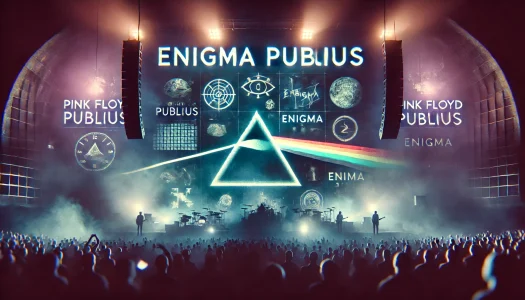Pink Floyd, one of the most iconic and influential progressive rock bands, was known for its complex music, conceptual albums, and cryptic visuals. By 1994, the band had entered a new era with The Division Bell, their fourteenth studio album and second without founding member Roger Waters. The album dealt with themes of communication and conflict, marking a reflective period for the band as they grappled with their own internal tensions and creative evolution.
Amid the success of The Division Bell, a mysterious puzzle known as the “Publius Enigma” emerged, captivating fans. It all began with an anonymous post on an early internet forum, cryptically promising a hidden riddle linked to the album. The enigma sparked widespread speculation, with fans eager to uncover its meaning, but it also created confusion. Decades later, the Publius Enigma remains unsolved, becoming one of the most enduring mysteries in Pink Floyd’s storied history, fueling debates and curiosity within their global fanbase.
Origins of the Publius Enigma

The Publius Enigma conspiracy first surfaced in 1994 on the Usenet group alt.music.pink-floyd, a popular online forum for Pink Floyd fans. On June 11th, an anonymous user under the name “Publius” posted a cryptic message that hinted at a hidden riddle connected to the band’s latest album, The Division Bell. The message read:
My friends, You have heard the message Pink Floyd has delivered, but have you listened? Perhaps I can be your guide, but I will not solve the enigma for you. All of you must open your minds and communicate…
The message went on to promise a significant reward for whoever could unravel the puzzle, though it gave no clear indication of what that reward was or how to solve it. The vagueness of Publius’ statements, combined with the authoritative and mysterious tone, immediately piqued the interest of fans. However, no concrete clues were given, leaving the community to interpret the posts for themselves. What followed was a wave of speculation, with many fans digging into lyrics, artwork, and live shows in hopes of finding hidden meanings.
Fan Reactions and Early Investigations
Fans were immediately intrigued by the enigmatic posts from Publius, but reactions ranged from curiosity to skepticism. The cryptic nature of the messages, combined with the promise of a significant reward, led many to believe that the Publius Enigma was more than just an internet prank. Some thought it might be a marketing stunt by Pink Floyd or their label to promote The Division Bell. Others speculated that the Enigma was a deep, hidden message embedded in the album’s music, lyrics, or artwork.
Early investigations saw dedicated fans scouring every aspect of The Division Bell in search of clues. They analyzed the album’s lyrics for cryptic meanings, dissected the artwork for hidden symbols, and even studied the band’s live performances for potential visual hints. Some believed the Enigma could be a philosophical puzzle or a treasure hunt, while others speculated it was a secret message left behind by the band members themselves.
Fans also latched onto the album’s themes of communication and miscommunication, wondering if the Enigma was linked to these concepts. Many took to the internet to collaborate, pooling their theories and discoveries in an attempt to crack the code. Despite the growing excitement, no definitive answers emerged, but the ongoing speculation only deepened the mystery and kept the fanbase hooked on solving the elusive Publius Enigma.
The Role of Pink Floyd’s Live Shows
The intrigue surrounding the Publius Enigma escalated during The Division Bell tour, when Pink Floyd’s live shows seemed to provide cryptic validation of the mysterious messages. During a concert at the Giants Stadium in New Jersey on July 18, 1994, a pivotal moment occurred that cemented the Enigma in fan consciousness. As the band played, a message reading “ENIGMA PUBLIUS” appeared on the stage’s lighting screen, visible to the entire audience.
This public display of the Enigma’s name sent shockwaves through the fanbase, leading many to believe that the puzzle was indeed sanctioned by the band or its management. Up until this point, fans had been unsure whether the Usenet posts from Publius were part of an official Pink Floyd project or simply an elaborate hoax. The message at the live show, along with subsequent lighting displays in other concerts, seemed to provide undeniable proof that the Enigma was tied to the band’s live performances.
This moment turned the Publius Enigma into a full-blown phenomenon, with fans now scrutinizing every detail of the tour, from the stage visuals to setlists, in search of further clues. Some speculated that the elaborate light displays and the band’s iconic use of visual symbolism might be part of a hidden message connected to the puzzle. The appearance of the Enigma’s name at a live event blurred the lines between fan speculation and official endorsement, fueling the ongoing mystery and deepening the obsession with solving the puzzle.
Theories and Interpretations
As the Publius Enigma captivated Pink Floyd’s fanbase, a range of theories emerged about its true purpose. One of the most popular interpretations was that the Enigma was a clever marketing stunt designed to generate buzz around The Division Bell. Fans pointed to the timing of the Usenet posts and the public appearance of the “ENIGMA PUBLIUS” message during live shows as evidence that the puzzle was orchestrated by the band or its label to keep interest in the album high. The mystery certainly succeeded in drawing attention, especially in the early days of the internet, where such viral marketing was still a novel concept.
Another prevalent theory was that the Publius Enigma contained a deeper, hidden philosophical meaning. Given Pink Floyd’s history of exploring abstract and thought-provoking themes, many fans believed the Enigma was not just a game but a complex riddle connected to the album’s core messages. The Division Bell dealt heavily with ideas of communication, isolation, and human connection—topics that resonated with listeners and seemed like fertile ground for a puzzle to unfold. Some fans theorized that the Enigma was a symbolic quest meant to challenge listeners to think more deeply about the nature of communication, echoing the album’s lyrics and themes of reconciliation and understanding.
A third possibility, and perhaps the most frustrating for fans, was that the Publius Enigma was simply an unsolved puzzle with no resolution. Despite decades of speculation and investigation, no one has definitively cracked the code or claimed the promised reward. This led some to wonder if the Enigma was intentionally left incomplete, meant to be an enduring mystery, or if it had been abandoned before a solution could ever be reached.
Resolution or Lack Thereof
To this day, the Publius Enigma remains officially unsolved. Despite years of fan investigation and speculation, no one has definitively cracked the riddle or claimed the promised reward. Pink Floyd and their management have remained mostly silent or vague about the Enigma, fueling the idea that it might never have been meant to reach a clear resolution.
Over the years, there have been sporadic hints from those involved with the band. In a 2005 interview, Pink Floyd’s long-time collaborator and artwork designer, Storm Thorgerson, hinted that the Enigma was real but did not elaborate further. Similarly, in a 1996 interview, drummer Nick Mason acknowledged the Enigma but gave no concrete answers, leaving fans with the same ambiguity that has surrounded the mystery from the start.
Some fans believe the Enigma was a marketing ploy that was never intended to have a true solution, while others continue to search for hidden meanings within The Division Bell and the band’s visuals. Despite the lack of official closure, the Enigma has taken on a life of its own within Pink Floyd’s lore, becoming a part of the band’s enduring mystique. It serves as a reminder of the band’s penchant for cryptic artistry and their ability to inspire decades of fan engagement through unanswered questions.
